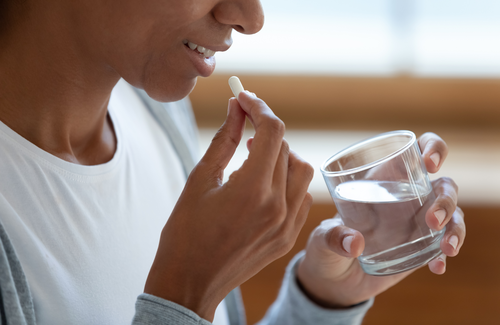
A comparison between the people allocated to oral PrEP in the two pivotal studies that compared it to injectable PrEP, HPTN 083 and HPTN 084, has found that the pills provided 99% protection against HIV infection to the gay and bisexual men and transgender women in HPTN 083 as long as they consistently took two or more pills a week. But the cisgender African women in HPTN 084 had to maintain daily PrEP – all seven pills a week – to receive the same efficacy.
The study also found that adherence to oral PrEP in the women taking part in HPTN 084 was considerably lower than in the participants in HPTN 083, thus reducing its efficacy even further. This contributed to the fact that while injectable cabotegravir was 66% more effective than oral PrEP in the latter study, it was 91% more effective in the former.
The study by Professors Peter Anderson, Mark Marzinke and David Glidden is the latest study to find that the antiretroviral drug tenofovir takes longer to reach effective concentrations in vaginal tissue cells than it does in rectal tissue cells, and may never reach such completely protective levels.
Tenofovir can be given as two different prodrugs – tenofovir disoproxil (TDF) and tenofovir alafenamide (TAF) but gets turned into the active drug inside cells. The HPTN studies used TDF, and we still don’t have data on TAF’s efficacy as PrEP in women.
The second drug in oral PrEP can be either emtricitabine (FTC) or lamivudine (3TC). Both contribute importantly to efficacy, especially in women; but they do not persist so long in cells, so tenofovir levels are a better guide to adherence and its relationship to efficacy.
The study
In both studies, blood plasma drug levels were measured in samples taken at every two-monthly clinic visit, and levels inside red blood cells were measured in dried blood spot (DBS) samples taken every third clinic visit, i.e. every six months. Blood plasma levels reveal drug levels in the week before the sample is taken, whereas DBS levels reveal average adherence levels over a period of months.
The protective levels of efficacy were derived by looking at the blood plasma levels of drug taken at the visit when the person tested HIV-positive and also at the visit before that. These were correlated with DBS levels. Blood plasma levels usually correlate broadly with the longer-term patterns of adherence revealed in the DBS samples. If they don’t – for instance if a high blood plasma level of drug is seen despite low DBS levels – then this suggests that the person has only taken a dose or two of PrEP before coming to the clinic (so-called ‘white coat dosing’).
There were 39 infections on TDF/FTC versus 12 on injectable cabotegravir in HPTN 083, and 36 versus three in HPTN 084. Evidence of white-coat dosing was seen in eight cases (25%) in HPTN 084, but only three (8%) in HPTN 083.
Average long-term levels of adherence were estimated by looking at the DBS levels in all participants taking oral PrEP who acquired HIV. Although the evidence linking levels in red blood cells with frequency of dosing comes from studies in gay men, there is no reason to think they differ in women. Levels of over 1250 femtomols in each sample indicated daily dosing, 700-1250 4-6 doses a week, 350-700 2-4 doses a week, and below 350 but detectable, 0-2 doses a week. (A femtomol is a trillionth of a mole, but 350 femtomols still means 2100 trillion individual tenofovir molecules per sample.)
It is already known from other studies that more than four doses of PrEP a week appear to be fully protective for gay men taking PrEP pills. The figures from HPTN 083 confirmed this, and even strengthened the evidence. Virtually all the infections in gay and bisexual men and transgender women taking oral TDF/FTC in that trial who acquired HIV were taking either no PrEP or less than two doses a week. In fact, while undetectable levels of TDF/FTC in either trial offered zero efficacy, in HPTN 083 even taking some, but less than two, doses a week offered, it was estimated, about 50% efficacy (though statistical uncertainty means the ‘true’ figure could have been anywhere from zero to 70%).
But for anything more than two doses a week, the calculated efficacy was 99%, and even the lower bound of the 95% confidence interval (i.e. the lowest likely ‘true’ doses needed, given statistical uncertainty) was 93% for 2-4 doses a week and 98% or four or more.
The situation for cisgender women taking part in HPTN 084 was very different. If the women managed daily dosing (as measured by DBS) the average likely efficacy was 99%. But if they took 4-6 doses a week it was 88% and 2-4 doses, 80%. But for women who took fewer than two doses, it was statistically equivalent to zero.
However the 95% confidence intervals for women were extremely wide for anything more than two doses a week. The ‘true’ efficacy for 2-3 doses could be anything between 32% to 97%, and for 4-6 doses, 43-99%. For daily dosing the 95% confidence interval was as wide as it could be: from zero to 99%.
(What does that even mean in practice? It means that, although 99% is the most frequent efficacy result you’d see for daily dosing, if you, purely theoretically, ran exactly the same study 20 times, the result you’d get, due to statistical ‘noise’, has a 5% chance of being as low as zero at least once.)
The reason why uncovers perhaps the most startling find of the study. As with many other PrEP studies and demonstration projects very few women actually took PrEP every day, and in fact most took almost none.
Comparing the two studies shows that in HPTN 083, 73% of the men and trans women were taking four or more doses of PrEP a week, including 34% who were taking it daily. Only 18% took two or fewer doses a week.
In contrast, in HPTN 084, only 18% of the cisgender women were taking four or more doses a week (only 3% took it daily), and 64% were taking two doses or fewer.
Given that even adequate efficacy needs more than four doses a week to work in women, fewer than 18% in the TDF/FTC arm of the HPTN 084 study were protected by PrEP pills. In contrast, at least 73% of participants in HPTN 083, and possibly up to 82% were protected.
Bad news for women? Not if they were on injectable cabotegravir. In the blinded phase of the studies there were 12 HIV infections in HPTN 083 among the gay and bisexual men and transgender women who received cabotegravir – including three which mysteriously happened in people with apparently full adherence. In HPTN 084, there were only three infections, all in women who missed scheduled injections. Another HPTN 084 analysis discovered that cabotegravir drug levels in the women in HPTN 084 were actually higher than they were in HPTN 083 participants, and this could mean that quarterly dosing of injectable PrEP could work in women.
Anderson PL, Marzinke MA, Glidden DV. Updating the adherence-response for oral F-TDF for PrEP among cisgender women. Clinical Infectious Diseases, online ahead of print, 16 January 2023.

